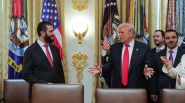- Home
- Middle East
- Tehran–Washington: Toward a Thaw or a Deadlock?

US-Iranian nuclear talks ©This is Beirut
Iran and the United States held indirect negotiations on Saturday, mediated by the Sultanate of Oman, focused on Iran’s nuclear program. These talks are making headlines amid a lack of transparency about their content and progress.
A Second Round in Rome
According to Dutch Foreign Minister Caspar Veldkamp, a second round of negotiations is set to take place this Saturday in Rome. The venue shift is notable: Washington’s proposal to move the talks to the Italian capital signals a desire to institutionalize the dialogue. Meanwhile, Iranian Foreign Minister Abbas Araghchi is expected in Moscow on Monday to brief his Russian counterpart on the evolving Tehran–Washington discussions.
The Trump administration expressed satisfaction with the initial round of negotiations in Oman, which succeeded in moving the format from indirect (via intermediaries) to direct talks involving officials from both sides. According to an American source cited by Axios, the conversation was “substantial, serious, and excellent.” The source noted it was the highest-level dialogue between American and Iranian officials in eight years.
What Are the Demands?
No action comes without expected benefits. Isolated from much of the international community and reliant on alliances with Russia and China, Iran is grappling with a crumbling economy. Its GDP per capita is under $4,500—barely ahead of crisis-hit Lebanon—and its economy has contracted by 8% over the past two years, according to the International Monetary Fund.
Lifting sanctions is therefore a top priority for Tehran. The regime hopes to regain access to global markets and unlock more than $100 billion in frozen assets. The U.S. and its European allies, however, insist that any concessions be tied to verifiable limits on Iran’s nuclear activities, particularly the cessation of uranium enrichment to 60%, a level edging close to weapons-grade.
But deep-seated mistrust lingers. Iran recalls the U.S. withdrawal from the 2015 Joint Comprehensive Plan of Action (JCPOA) in 2018 and is demanding guarantees that history won’t repeat itself. Washington, for its part, suspects Tehran of stalling to buy time for further nuclear development.
Regional Watchdogs
Regional actors are watching the talks with concern, carefully monitoring every development at the negotiation table. Israel, firmly opposed to any compromise, continues to sound alarms and has maintained its airstrikes on Gaza, a Hamas stronghold backed by Tehran.
The International Atomic Energy Agency (IAEA) is also playing a key role. Its director, Rafael Grossi, is expected in Tehran this week to assess the transparency of Iran’s nuclear sites—an essential step before any diplomatic breakthrough.
And What About Riyadh?
Long viewed as a fierce opponent of any nuclear deal with Iran, Saudi Arabia is now adopting a more measured stance. This shift reflects a broader regional détente, encouraged by China, which facilitated an unprecedented thaw between Riyadh and Tehran in 2023.
But despite the outward diplomacy, Saudi Arabia remains deeply cautious. Officials in the Kingdom worry that sanctions relief could enable Iran to double down on its support for proxy groups—especially the Houthis in Yemen—and further expand its military footprint.
Riyadh’s position is clear: any progress must come with solid security guarantees for the Gulf.
Calculated Moves
As the second round of talks in Rome approaches, dynamics appear to be shifting—but mistrust remains deeply rooted. Each side is moving its pawns cautiously, calculating risks and weighing gains.
While the prospect of a breakthrough seems within reach, it remains fragile—hinging on solid guarantees, shifting political agendas, and regional rivalries.
Between Washington and Tehran, nothing is ever truly settled. Everything remains open to negotiation.
Read more




Comments